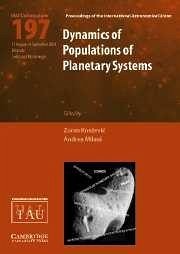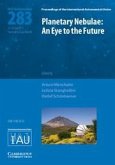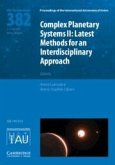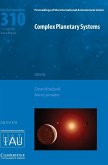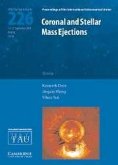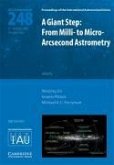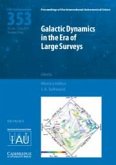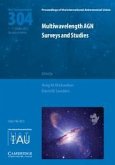Zoran Knezevic (ed.)
Dynamics of Populations of Planetary Systems (Iau C197)
Herausgeber: Knezevic, Zoran; Milani, Andrea
Zoran Knezevic (ed.)
Dynamics of Populations of Planetary Systems (Iau C197)
Herausgeber: Knezevic, Zoran; Milani, Andrea
- Gebundenes Buch
- Merkliste
- Auf die Merkliste
- Bewerten Bewerten
- Teilen
- Produkt teilen
- Produkterinnerung
- Produkterinnerung
Recent advances in computational power are now enabling scientists to consider problems of population dynamics at an advanced level regarding the small bodies of our solar system, the planets around other stars, dust belts, space debris, etc., and their collective dynamical evolution, stability and instability, order and chaos, aggregations and impacts. Important results on specific populations of celestial bodies, in addition to new methods of computation and analysis, have been obtained in the last few years. This proceedings volume reviews current understanding of the field, and is a…mehr
Andere Kunden interessierten sich auch für
![Planetary Nebulae (Iau S283) Planetary Nebulae (Iau S283)]() Planetary Nebulae (Iau S283)83,99 €
Planetary Nebulae (Iau S283)83,99 €![Complex Planetary Systems II (Iau S382) Complex Planetary Systems II (Iau S382)]() Complex Planetary Systems II (Iau S382)142,99 €
Complex Planetary Systems II (Iau S382)142,99 €![Complex Planetary Systems (IAU S310) Complex Planetary Systems (IAU S310)]() Complex Planetary Systems (IAU S310)100,99 €
Complex Planetary Systems (IAU S310)100,99 €![Coronal and Stellar Mass Ejections (Iau S226) Coronal and Stellar Mass Ejections (Iau S226)]() Kenneth Dere / Jingxiu Wang / Yihua Yan (eds.)Coronal and Stellar Mass Ejections (Iau S226)88,99 €
Kenneth Dere / Jingxiu Wang / Yihua Yan (eds.)Coronal and Stellar Mass Ejections (Iau S226)88,99 €![A Giant Step: From MILLI- To Micro- Arcsecond Astrometry (Iau S248) A Giant Step: From MILLI- To Micro- Arcsecond Astrometry (Iau S248)]() A Giant Step: From MILLI- To Micro- Arcsecond Astrometry (Iau S248)103,99 €
A Giant Step: From MILLI- To Micro- Arcsecond Astrometry (Iau S248)103,99 €![Galactic Dynamics in the Era of Large Surveys (IAU S353) Galactic Dynamics in the Era of Large Surveys (IAU S353)]() Galactic Dynamics in the Era of Large Surveys (IAU S353)156,99 €
Galactic Dynamics in the Era of Large Surveys (IAU S353)156,99 €![Multiwavelength Agn Surveys and Studies (Iau S304) Multiwavelength Agn Surveys and Studies (Iau S304)]() Multiwavelength Agn Surveys and Studies (Iau S304)82,99 €
Multiwavelength Agn Surveys and Studies (Iau S304)82,99 €-
-
-
Recent advances in computational power are now enabling scientists to consider problems of population dynamics at an advanced level regarding the small bodies of our solar system, the planets around other stars, dust belts, space debris, etc., and their collective dynamical evolution, stability and instability, order and chaos, aggregations and impacts. Important results on specific populations of celestial bodies, in addition to new methods of computation and analysis, have been obtained in the last few years. This proceedings volume reviews current understanding of the field, and is a valuable resource for professional astronomers and planetary scientists.
Produktdetails
- Produktdetails
- Verlag: Cambridge University Press
- Seitenzahl: 506
- Erscheinungstermin: 16. Mai 2005
- Englisch
- Abmessung: 252mm x 177mm x 28mm
- Gewicht: 1188g
- ISBN-13: 9780521852036
- ISBN-10: 052185203X
- Artikelnr.: 22458401
- Herstellerkennzeichnung
- Libri GmbH
- Europaallee 1
- 36244 Bad Hersfeld
- gpsr@libri.de
- Verlag: Cambridge University Press
- Seitenzahl: 506
- Erscheinungstermin: 16. Mai 2005
- Englisch
- Abmessung: 252mm x 177mm x 28mm
- Gewicht: 1188g
- ISBN-13: 9780521852036
- ISBN-10: 052185203X
- Artikelnr.: 22458401
- Herstellerkennzeichnung
- Libri GmbH
- Europaallee 1
- 36244 Bad Hersfeld
- gpsr@libri.de
1. Resonances and stability of extra-solar planetary systems C. Beaugé, N.
Callegari, S. Ferraz-Mello and T. A. Michtchenko; 2. Formation, migration,
and stability of extrasolar planetary systems Fred C. Adams; 3. Dynamical
evolution of extrasolar planetary systems Ji-Lin Zhou and Yi-Sui Sun; 4.
Dynamics of planetesimals: the role of two-body relaxation Eiichiro Kokubo;
5. Fitting orbits Andrzej J. Maciejewski, Krzysztof Gozdziewski and Szymon
Kozlowski; 6. The secular planetary three body problem revisited Jacques
Henrard and Anne-Sophie Libert; 7. Dynamics of extrasolar systems at the
5/2 resonance: application to 47 UMa Dionyssia Psychoyos and John D.
Hadjidemetriou; 8. Our solar system as model for exosolar planetary systems
Rudolf Dvorak, Áron Süli and Florian Freistetter; 9. Planetary motion in
double stars: the influence of the secondary Elke Pilat-Lohinger; 10.
Planetary orbits in double stars: influence of the binary's orbital
eccentricity Daniel Benest and Robert Gonczi; 11. Astrometric observations
of 51 Peg and Gliese 623 at Pulkovo observatory with 65 cm refractor N. A.
Shakht; 12. Observations of 61 Cyg at Pulkovo Denis L. Gorshanov, N. A.
Shakht, A. A. Kisselev and E. V. Poliakow; 13. Formation of the solar
system by instability Evgeny Griv and Michael Gedalin; 14. Behaviour of a
two-planetary system on a cosmogonic time-scale Konstantin V. Kholshevnikov
and Eduard D. Kuznetsov; 15. Boundaries of the habitable zone: unifying
dynamics, astrophysics, and astrobiology Milan M. Cirkovic; 16. Asteroid
proper elements: recent computational progress Fernando Roig and Cristian
Beaugé; 17. Asteroid family classification from very large catalogues Anne
Lemaitre; 18. Non-gravitational perturbations and evolution of the asteroid
main belt David Vokrouhlicky, M. Broz and W. F. Bottke, D. Nesvorny and A.
Morbidelli; 19. Diffusion in the asteroid belt Harry Varvoglis; 20.
Accurate model for the Yarkovsky effect David Capek and David Vokrouhlicky;
21. The population of asteroids in the 2:1 mean motion resonance with
Jupiter revised Miroslav Broz, D. Vokrouhlicky, F. Roig, D. Nesvorny, W. F.
Bottke and A. Morbidelli; 22. On the reliability of computation of maximum
Lyapunov Characteristic Exponents for asteroids Zoran Knezevic and Slobodan
Ninkovic; 23. Nekhoroshev stability estimates for different models of the
Trojan asteroids Christos Efthymiopoulos; 24. The role of the resonant
'stickiness' in the dynamical evolution of Jupiter family comets A.
Alvarez-Canda and F. Roig; 25. Regimes of stability and scaling relations
for the removal time in the asteroid belt: a simple kinetic model and
numerical tests Mihailo Cubrovic; 26. Virtual asteroids and virtual
impactors Andrea Milani; 27. Asteroid population models Alessandro
Morbidelli; 28. Linking Very Large Telescope asteroid observations M.
Granvik, K. Muinonen, J. Virtanen, M. Delbó, L. Saba, G. De Sanctis, R.
Morbidelli, A. Cellino and E. Tedesco; 29. Collision orbits and phase
transition for 2004 AS1 at discovery Jenni Virtanen, K. Muinonen, M.
Granvik and T. Laakso; 30. The size of collision solutions in orbital
elements space G. B. Valsecchi, A. Rossi, A. Milani and S. R. Chesley; 31.
Very short arc orbit determination: the case of asteroid 2004 FU162 Steven
R. Chesley; 32. Nonlinear impact monitoring: 2-dimensional sampling Giacomo
Tommei; 33. Searching for gravity assisted trajectories to accessible
near-Earth asteroids Stefan Berinde; 34. KLENOT - Near Earth and other
unusual objects observations Michal Kocer, Jana Tichá and M. Tichy; 35.
Transport of comets to the Inner Solar System Hans Rickman; 36.
Nongravitational Accelerations on Comets Steven R. Chesley and Donald K.
Yeomans; 37. Interaction of planetesimals with the giant planets and the
shaping of the trans-Neptunian belt Harold F. Levison and Alessandro
Morbidelli; 38. Transport of comets to the outer p
Callegari, S. Ferraz-Mello and T. A. Michtchenko; 2. Formation, migration,
and stability of extrasolar planetary systems Fred C. Adams; 3. Dynamical
evolution of extrasolar planetary systems Ji-Lin Zhou and Yi-Sui Sun; 4.
Dynamics of planetesimals: the role of two-body relaxation Eiichiro Kokubo;
5. Fitting orbits Andrzej J. Maciejewski, Krzysztof Gozdziewski and Szymon
Kozlowski; 6. The secular planetary three body problem revisited Jacques
Henrard and Anne-Sophie Libert; 7. Dynamics of extrasolar systems at the
5/2 resonance: application to 47 UMa Dionyssia Psychoyos and John D.
Hadjidemetriou; 8. Our solar system as model for exosolar planetary systems
Rudolf Dvorak, Áron Süli and Florian Freistetter; 9. Planetary motion in
double stars: the influence of the secondary Elke Pilat-Lohinger; 10.
Planetary orbits in double stars: influence of the binary's orbital
eccentricity Daniel Benest and Robert Gonczi; 11. Astrometric observations
of 51 Peg and Gliese 623 at Pulkovo observatory with 65 cm refractor N. A.
Shakht; 12. Observations of 61 Cyg at Pulkovo Denis L. Gorshanov, N. A.
Shakht, A. A. Kisselev and E. V. Poliakow; 13. Formation of the solar
system by instability Evgeny Griv and Michael Gedalin; 14. Behaviour of a
two-planetary system on a cosmogonic time-scale Konstantin V. Kholshevnikov
and Eduard D. Kuznetsov; 15. Boundaries of the habitable zone: unifying
dynamics, astrophysics, and astrobiology Milan M. Cirkovic; 16. Asteroid
proper elements: recent computational progress Fernando Roig and Cristian
Beaugé; 17. Asteroid family classification from very large catalogues Anne
Lemaitre; 18. Non-gravitational perturbations and evolution of the asteroid
main belt David Vokrouhlicky, M. Broz and W. F. Bottke, D. Nesvorny and A.
Morbidelli; 19. Diffusion in the asteroid belt Harry Varvoglis; 20.
Accurate model for the Yarkovsky effect David Capek and David Vokrouhlicky;
21. The population of asteroids in the 2:1 mean motion resonance with
Jupiter revised Miroslav Broz, D. Vokrouhlicky, F. Roig, D. Nesvorny, W. F.
Bottke and A. Morbidelli; 22. On the reliability of computation of maximum
Lyapunov Characteristic Exponents for asteroids Zoran Knezevic and Slobodan
Ninkovic; 23. Nekhoroshev stability estimates for different models of the
Trojan asteroids Christos Efthymiopoulos; 24. The role of the resonant
'stickiness' in the dynamical evolution of Jupiter family comets A.
Alvarez-Canda and F. Roig; 25. Regimes of stability and scaling relations
for the removal time in the asteroid belt: a simple kinetic model and
numerical tests Mihailo Cubrovic; 26. Virtual asteroids and virtual
impactors Andrea Milani; 27. Asteroid population models Alessandro
Morbidelli; 28. Linking Very Large Telescope asteroid observations M.
Granvik, K. Muinonen, J. Virtanen, M. Delbó, L. Saba, G. De Sanctis, R.
Morbidelli, A. Cellino and E. Tedesco; 29. Collision orbits and phase
transition for 2004 AS1 at discovery Jenni Virtanen, K. Muinonen, M.
Granvik and T. Laakso; 30. The size of collision solutions in orbital
elements space G. B. Valsecchi, A. Rossi, A. Milani and S. R. Chesley; 31.
Very short arc orbit determination: the case of asteroid 2004 FU162 Steven
R. Chesley; 32. Nonlinear impact monitoring: 2-dimensional sampling Giacomo
Tommei; 33. Searching for gravity assisted trajectories to accessible
near-Earth asteroids Stefan Berinde; 34. KLENOT - Near Earth and other
unusual objects observations Michal Kocer, Jana Tichá and M. Tichy; 35.
Transport of comets to the Inner Solar System Hans Rickman; 36.
Nongravitational Accelerations on Comets Steven R. Chesley and Donald K.
Yeomans; 37. Interaction of planetesimals with the giant planets and the
shaping of the trans-Neptunian belt Harold F. Levison and Alessandro
Morbidelli; 38. Transport of comets to the outer p
1. Resonances and stability of extra-solar planetary systems C. Beaugé, N.
Callegari, S. Ferraz-Mello and T. A. Michtchenko; 2. Formation, migration,
and stability of extrasolar planetary systems Fred C. Adams; 3. Dynamical
evolution of extrasolar planetary systems Ji-Lin Zhou and Yi-Sui Sun; 4.
Dynamics of planetesimals: the role of two-body relaxation Eiichiro Kokubo;
5. Fitting orbits Andrzej J. Maciejewski, Krzysztof Gozdziewski and Szymon
Kozlowski; 6. The secular planetary three body problem revisited Jacques
Henrard and Anne-Sophie Libert; 7. Dynamics of extrasolar systems at the
5/2 resonance: application to 47 UMa Dionyssia Psychoyos and John D.
Hadjidemetriou; 8. Our solar system as model for exosolar planetary systems
Rudolf Dvorak, Áron Süli and Florian Freistetter; 9. Planetary motion in
double stars: the influence of the secondary Elke Pilat-Lohinger; 10.
Planetary orbits in double stars: influence of the binary's orbital
eccentricity Daniel Benest and Robert Gonczi; 11. Astrometric observations
of 51 Peg and Gliese 623 at Pulkovo observatory with 65 cm refractor N. A.
Shakht; 12. Observations of 61 Cyg at Pulkovo Denis L. Gorshanov, N. A.
Shakht, A. A. Kisselev and E. V. Poliakow; 13. Formation of the solar
system by instability Evgeny Griv and Michael Gedalin; 14. Behaviour of a
two-planetary system on a cosmogonic time-scale Konstantin V. Kholshevnikov
and Eduard D. Kuznetsov; 15. Boundaries of the habitable zone: unifying
dynamics, astrophysics, and astrobiology Milan M. Cirkovic; 16. Asteroid
proper elements: recent computational progress Fernando Roig and Cristian
Beaugé; 17. Asteroid family classification from very large catalogues Anne
Lemaitre; 18. Non-gravitational perturbations and evolution of the asteroid
main belt David Vokrouhlicky, M. Broz and W. F. Bottke, D. Nesvorny and A.
Morbidelli; 19. Diffusion in the asteroid belt Harry Varvoglis; 20.
Accurate model for the Yarkovsky effect David Capek and David Vokrouhlicky;
21. The population of asteroids in the 2:1 mean motion resonance with
Jupiter revised Miroslav Broz, D. Vokrouhlicky, F. Roig, D. Nesvorny, W. F.
Bottke and A. Morbidelli; 22. On the reliability of computation of maximum
Lyapunov Characteristic Exponents for asteroids Zoran Knezevic and Slobodan
Ninkovic; 23. Nekhoroshev stability estimates for different models of the
Trojan asteroids Christos Efthymiopoulos; 24. The role of the resonant
'stickiness' in the dynamical evolution of Jupiter family comets A.
Alvarez-Canda and F. Roig; 25. Regimes of stability and scaling relations
for the removal time in the asteroid belt: a simple kinetic model and
numerical tests Mihailo Cubrovic; 26. Virtual asteroids and virtual
impactors Andrea Milani; 27. Asteroid population models Alessandro
Morbidelli; 28. Linking Very Large Telescope asteroid observations M.
Granvik, K. Muinonen, J. Virtanen, M. Delbó, L. Saba, G. De Sanctis, R.
Morbidelli, A. Cellino and E. Tedesco; 29. Collision orbits and phase
transition for 2004 AS1 at discovery Jenni Virtanen, K. Muinonen, M.
Granvik and T. Laakso; 30. The size of collision solutions in orbital
elements space G. B. Valsecchi, A. Rossi, A. Milani and S. R. Chesley; 31.
Very short arc orbit determination: the case of asteroid 2004 FU162 Steven
R. Chesley; 32. Nonlinear impact monitoring: 2-dimensional sampling Giacomo
Tommei; 33. Searching for gravity assisted trajectories to accessible
near-Earth asteroids Stefan Berinde; 34. KLENOT - Near Earth and other
unusual objects observations Michal Kocer, Jana Tichá and M. Tichy; 35.
Transport of comets to the Inner Solar System Hans Rickman; 36.
Nongravitational Accelerations on Comets Steven R. Chesley and Donald K.
Yeomans; 37. Interaction of planetesimals with the giant planets and the
shaping of the trans-Neptunian belt Harold F. Levison and Alessandro
Morbidelli; 38. Transport of comets to the outer p
Callegari, S. Ferraz-Mello and T. A. Michtchenko; 2. Formation, migration,
and stability of extrasolar planetary systems Fred C. Adams; 3. Dynamical
evolution of extrasolar planetary systems Ji-Lin Zhou and Yi-Sui Sun; 4.
Dynamics of planetesimals: the role of two-body relaxation Eiichiro Kokubo;
5. Fitting orbits Andrzej J. Maciejewski, Krzysztof Gozdziewski and Szymon
Kozlowski; 6. The secular planetary three body problem revisited Jacques
Henrard and Anne-Sophie Libert; 7. Dynamics of extrasolar systems at the
5/2 resonance: application to 47 UMa Dionyssia Psychoyos and John D.
Hadjidemetriou; 8. Our solar system as model for exosolar planetary systems
Rudolf Dvorak, Áron Süli and Florian Freistetter; 9. Planetary motion in
double stars: the influence of the secondary Elke Pilat-Lohinger; 10.
Planetary orbits in double stars: influence of the binary's orbital
eccentricity Daniel Benest and Robert Gonczi; 11. Astrometric observations
of 51 Peg and Gliese 623 at Pulkovo observatory with 65 cm refractor N. A.
Shakht; 12. Observations of 61 Cyg at Pulkovo Denis L. Gorshanov, N. A.
Shakht, A. A. Kisselev and E. V. Poliakow; 13. Formation of the solar
system by instability Evgeny Griv and Michael Gedalin; 14. Behaviour of a
two-planetary system on a cosmogonic time-scale Konstantin V. Kholshevnikov
and Eduard D. Kuznetsov; 15. Boundaries of the habitable zone: unifying
dynamics, astrophysics, and astrobiology Milan M. Cirkovic; 16. Asteroid
proper elements: recent computational progress Fernando Roig and Cristian
Beaugé; 17. Asteroid family classification from very large catalogues Anne
Lemaitre; 18. Non-gravitational perturbations and evolution of the asteroid
main belt David Vokrouhlicky, M. Broz and W. F. Bottke, D. Nesvorny and A.
Morbidelli; 19. Diffusion in the asteroid belt Harry Varvoglis; 20.
Accurate model for the Yarkovsky effect David Capek and David Vokrouhlicky;
21. The population of asteroids in the 2:1 mean motion resonance with
Jupiter revised Miroslav Broz, D. Vokrouhlicky, F. Roig, D. Nesvorny, W. F.
Bottke and A. Morbidelli; 22. On the reliability of computation of maximum
Lyapunov Characteristic Exponents for asteroids Zoran Knezevic and Slobodan
Ninkovic; 23. Nekhoroshev stability estimates for different models of the
Trojan asteroids Christos Efthymiopoulos; 24. The role of the resonant
'stickiness' in the dynamical evolution of Jupiter family comets A.
Alvarez-Canda and F. Roig; 25. Regimes of stability and scaling relations
for the removal time in the asteroid belt: a simple kinetic model and
numerical tests Mihailo Cubrovic; 26. Virtual asteroids and virtual
impactors Andrea Milani; 27. Asteroid population models Alessandro
Morbidelli; 28. Linking Very Large Telescope asteroid observations M.
Granvik, K. Muinonen, J. Virtanen, M. Delbó, L. Saba, G. De Sanctis, R.
Morbidelli, A. Cellino and E. Tedesco; 29. Collision orbits and phase
transition for 2004 AS1 at discovery Jenni Virtanen, K. Muinonen, M.
Granvik and T. Laakso; 30. The size of collision solutions in orbital
elements space G. B. Valsecchi, A. Rossi, A. Milani and S. R. Chesley; 31.
Very short arc orbit determination: the case of asteroid 2004 FU162 Steven
R. Chesley; 32. Nonlinear impact monitoring: 2-dimensional sampling Giacomo
Tommei; 33. Searching for gravity assisted trajectories to accessible
near-Earth asteroids Stefan Berinde; 34. KLENOT - Near Earth and other
unusual objects observations Michal Kocer, Jana Tichá and M. Tichy; 35.
Transport of comets to the Inner Solar System Hans Rickman; 36.
Nongravitational Accelerations on Comets Steven R. Chesley and Donald K.
Yeomans; 37. Interaction of planetesimals with the giant planets and the
shaping of the trans-Neptunian belt Harold F. Levison and Alessandro
Morbidelli; 38. Transport of comets to the outer p

